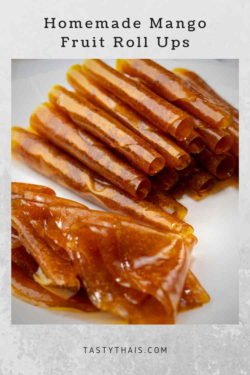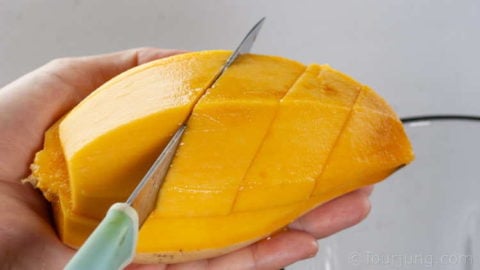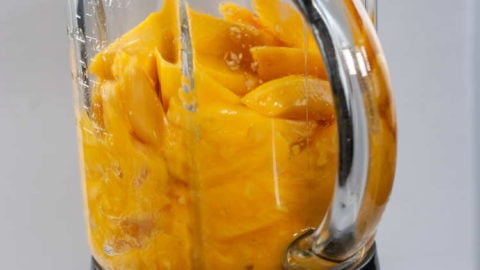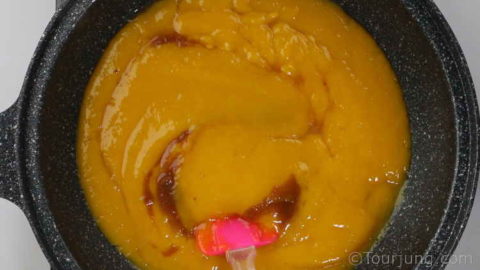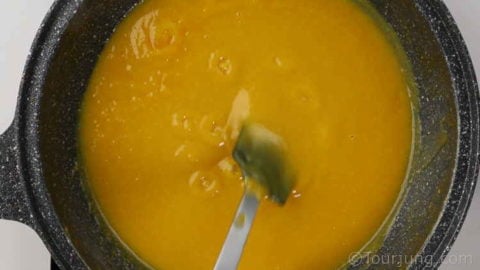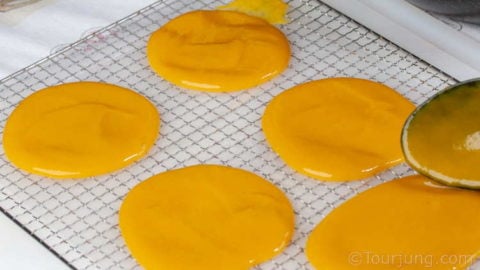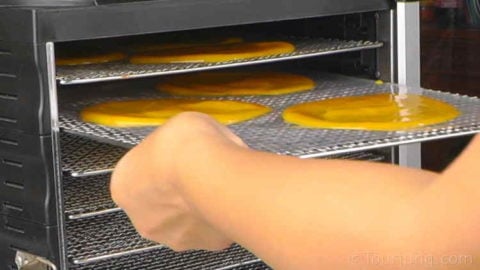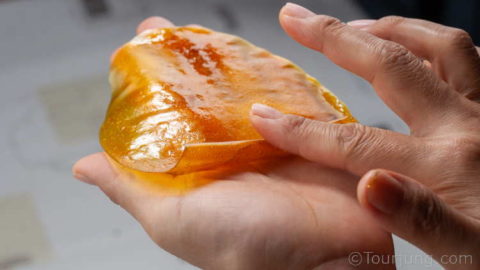Mango fruit roll ups are really easy to make with just four ingredients and a little patience while they slowly dry in the oven or dehydrator.
Full of vitamins and taste, these chewy mango rolls, which also go by the name mango fruit leather, are a great way to get kids to enjoy fruit at home or packed in a lunch box.
Video showing How to Make Mango Fruit Roll Ups
Link to video in case it does not load properly for you
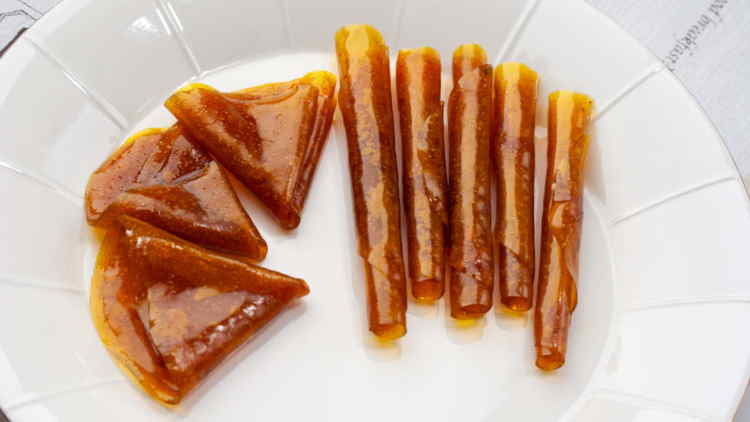
Are Fruit Roll Ups Healthy?
Fruit roll ups are essentially just fruit that is pureed and dried. The drying process slowly evaporates the water leaving most of the minerals of the fruit right there in the snack.
Some nutrients are lost, so eating fresh fruit will always give more nutrient value than cooked food. But trying to eat fresh mango is a messy business which is why fruit leather, mango in this recipe, makes for a very convenient way to get most of the fruity mineral and nutrient benefits.
Let’s face it, it’s much easier and less messy to eat a mango fruit roll up than getting messed up with the fresh fruit and so you are more likely to eat it.
You can add sugar if you want sweeter rolls but the more sugar you add the less healthy the snack! Adjusting the lime juice is better or use stevia which is a great alternative but does change the taste a little!
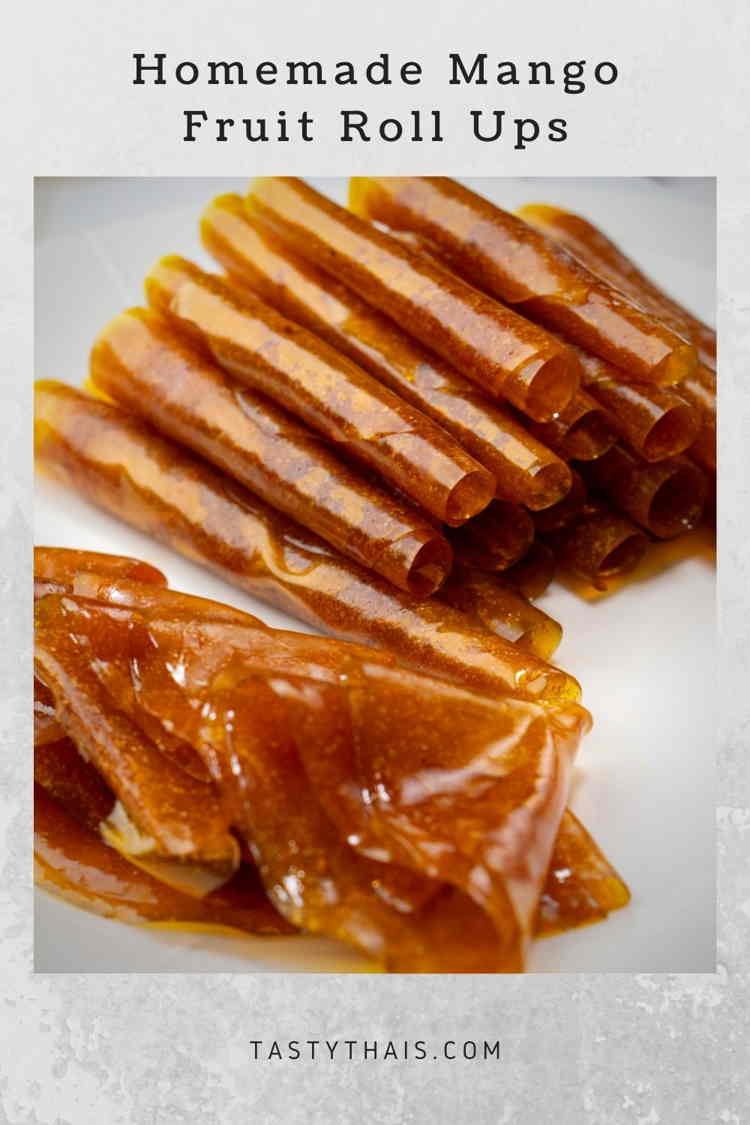
Tips on Making Mango Fruit Roll Ups
- Choosing the right mangoes makes a huge difference to your end result. Some mangoes are naturally quite sweet and others less so. Choosing a sweeter type of mango is much healthier than adding sugar!
- Mangoes should be ripe but not too ripe because nutrient loss occurs after the fruit is picked and left to ripen and you don’t want the extra water anyway.
- Blend the mango flesh well so it’s nice and smooth. When you are spreading the puree out make sure it is an even thickness. If it is thicker in some places and thinner in others then you will either have parts that are overly dry or parts that are too wet. Too wet is bad because moisture encourages mold and deterioration so your fruit rolls will not last so long.
- Adjust sweetness by the amount of tamarind and lime added rather than adding sugar.
- You want to use a silicone baking mat or heat resistant plastic (we had some leftover hot food bags we used) to spread your mango puree on as it will make it much easier to peel off afterward.
- You can use an oven or a dehydrator to dry the fruit puree but be aware of the temperature – 65°C to 70°C. Longer at a lower temperature is better than too high a temperature. Timing will vary a lot according to the efficiency of your oven or dehydrator and thickness of your spread.
- Forming round shapes when spreading to dehydrate make the fruit roll ups easier to roll. Rectangular baking sheet sized fruit leather is more efficient but needs to be cut into mango strips before rolling.
If you like mangoes then you might also like to try out our authentic Thai mango sticky rice recipe or our mango sticky rice cake. Our delicious Thai mango lassi is an awesome drink to try as well!
Making Mango Fruit Roll Ups – Step by Step
Step 1 – Selecting, Peeling and Slicing the Mango
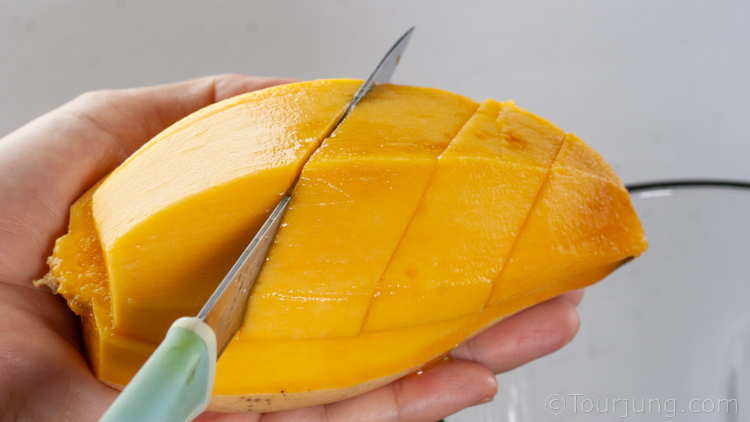
Select ripe and semi-firm mangoes that are free from bruises or too many dark spots on the skin. Dark spots are an indication the mango is getting overripe.
Peel the fruit to remove the skin and fibrous layer immediately below the skin. If you peel too thinly the fibers will be left attached to the flash and make the puree stringy and less smooth.
The easiest way to slice the mango is to peel one half lengthwise and use a sharp knife to carefully slice the flesh just above the kernel, chopping it up and tipping it into the blender.
Then peel the other side and chop into the blender and then slice any remaining flesh from the sides and around the kernel and add it.
Step 2 – Blending
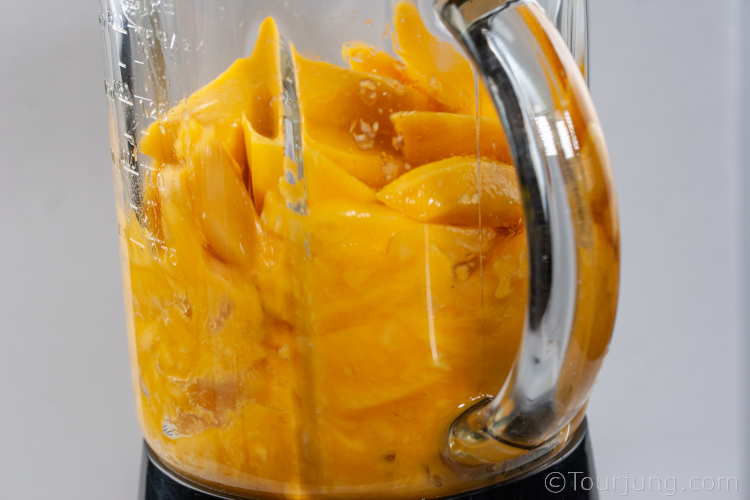
Blend the mango flesh without adding anything else. It’s better to adjust taste in the next stage.
Just whizz on the lower setting of your blender for a few seconds and then finish on high speed until you have a smooth and consistent puree.
You can use a food processor but a blender is the better tool for the job!
Step 3 – Seasoning
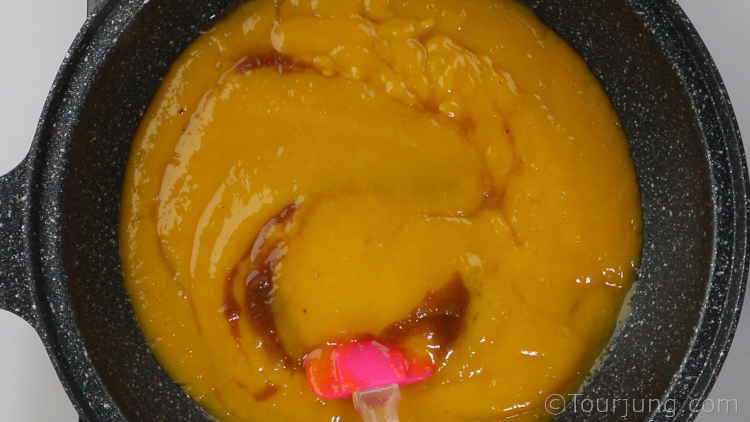
Transfer the puree into a pan and taste to check the taste. Use your judgement to add in the lime juice, salt, and tamarind paste.
Adjust the amounts depending on your personal preference and the sweetness of the puree. The taste should be a mix of sweet and sour with a slight saltiness.
Most children prefer a slightly sweeter taste so reduce the lime and tamarind which both add sourness.
Step 4 – Reducing
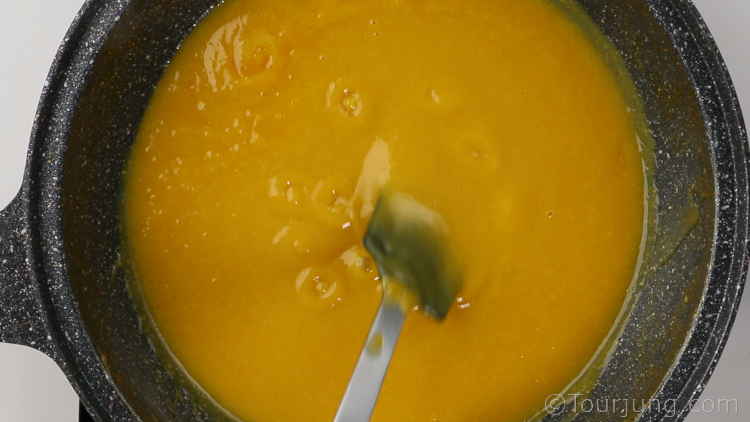
Once you have seasoned to taste the mixture needs to be reduced to evaporate most of the water quicker than will happen during the drying process.
Use a low to medium heat just sufficient to get the mixture to a slow simmer and stir frequently. A low to medium heat will reduce the quickness the mixture will burn where it is touching the hot pan surface.
Allow to simmer for 25 minutes or so but timing will depend on your equipment and just how fast the mixture is simmering. The amount of juice in your raw mangoes also affects timing so check as you stir from time to time.
How far you go with the simmering stage will make a huge difference in how long you have to dehydrate for.
You have reduced enough when the mixture is the consistency of thick custard.
Step 5 – Dehydrating
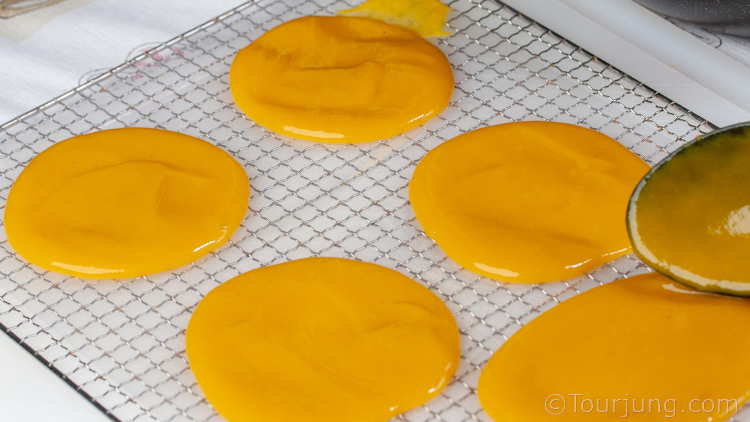
Whether you are using a dehydrator or oven, spread the mango fruit puree evenly on a flexible, heat resistant, non-stick surface.
Silicone baking mats are great if they will fit or you can improvise. Parchment paper or a baking sheet supported on a flat baking tray will do the job or you can copy us and cut up heat resistant plastic food bags but you do need to ensure the plastic tolerates heat!
Parchment paper (coated with silicone) and wax paper (coated with wax) are not quite as good a choice as plastic sheets or silicone mats because it can tear easier than plastic or silicone.
Whatever you use it is important that it sits flat otherwise the mango puree will slowly run downhill and become unevenly thick as well as unevenly dried.
We found it easier to spread the mango puree into hand-sized sections which will avoid having to cut up the mango leather in order to roll it into portion-sized rolls.
Use paper or plastic if you want to make baking sheet sized pieces and cut up later otherwise you’ll run the risk of damaging your silicone mats.
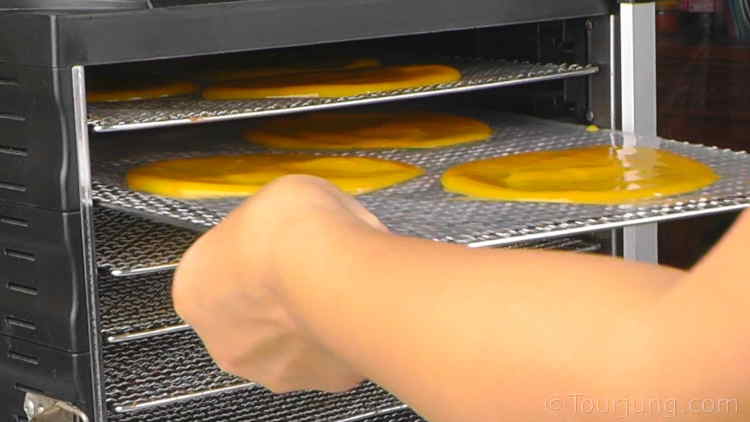
Set your machine to a temperature of 170°F (75°C) or lower and dehydrate for as long as necessary to finish your mango fruit leather.
We can’t tell you exactly how long will be needed as timing depends hugely on several factors – how much water is left in the puree, how thick you spread it, machine efficiency, and temperature for starters!
Check every so often until the thickest parts of your homemade mango are just tacky to the touch – similar to the sticky bit of a sticky note. You want it chewy, not dried and crunchy!
If any of the ‘jam’ sticks to your fingers it needs longer to dry.
Step 6 – Making Roll Ups
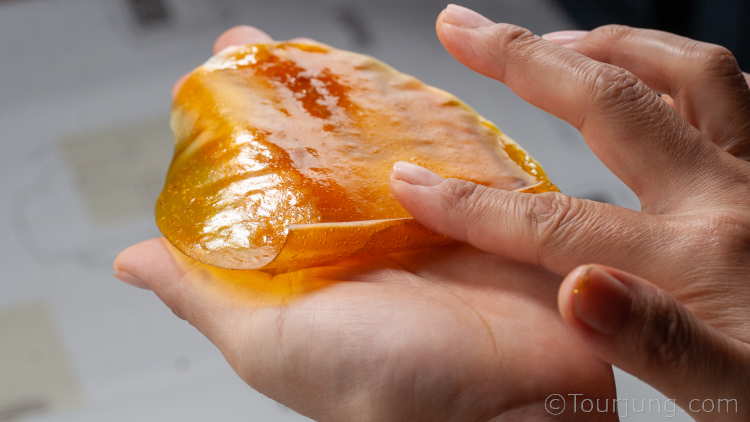
Once you are done dehydrating it is time to pull off the finished mango fruit leather and turn it into roll ups or little triangles. This makes them easy to eat, pack and store as well as look more mouthwatering.
Just bend the backing sheet, mat, or plastic away from the fruit leather and rub or pull it off so start. Once you have separated a corner you will be able to simply peel it right away.
If you have formed your mango into rounds you can just curl each one into a mango roll. If you have made big rectangular sheets then cut into smaller rectangles and then form the mango strips into roll ups or triangular bites.
Step 7 – Storing
If you are not going to eat your roll ups straight away then you can store them in a zip lock bag, vaccuumed freezer bag or airtight container for several months in the freezer or several days in the fridge.
Using an oxygen absorber is good to extend shelf life but not essential. They’ll be long eaten before they get old.
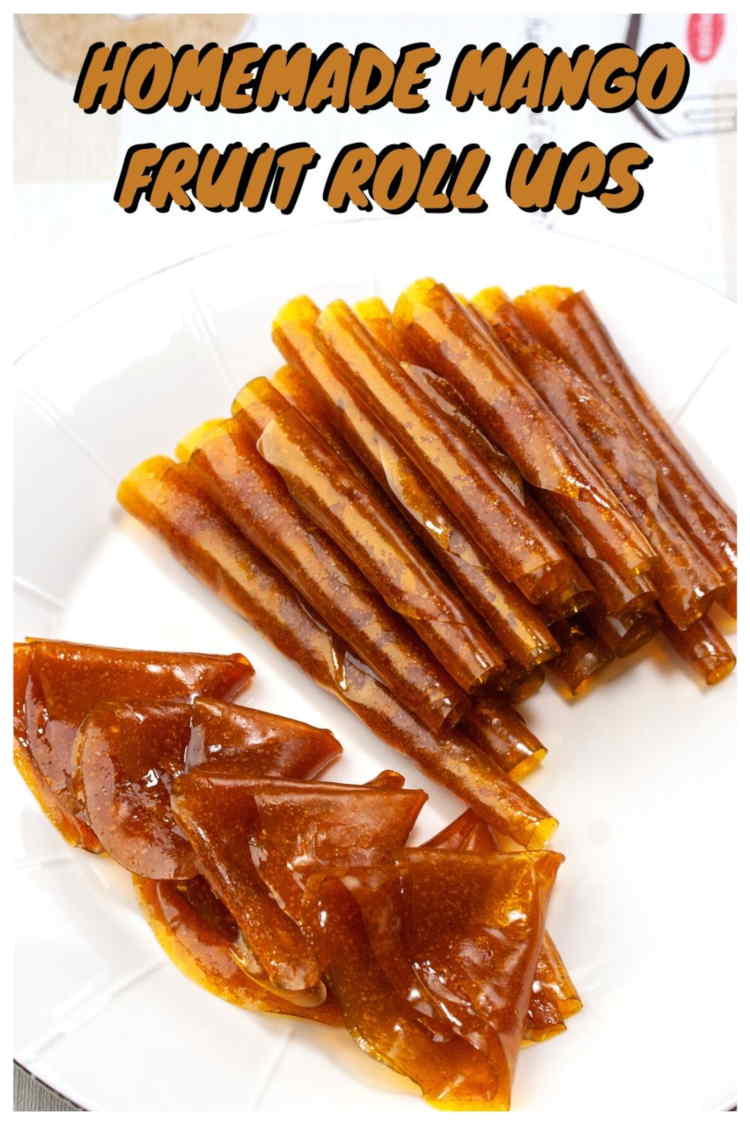
Mango Fruit Roll Ups Recipe
Homemade Mango Fruit Roll Ups – Healthy Thai Fruit Snack
The Video showing this recipe being cooked is near the top of the page – A convenient Jump Link to the video is below the description under here.
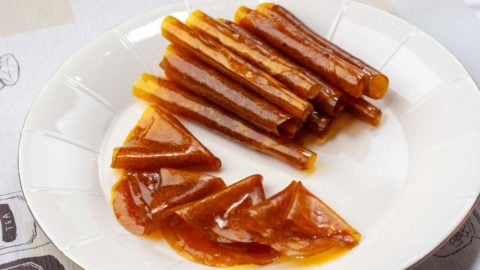
NOTE: Any In-recipe images can be toggled on and off with the camera icons next to the Instructions header.
Equipment
- Dehydrator or Oven with low heat setting around 160-175°F
- Blender
Ingredients
Ingredients
- 4½ lbs Ripe Mango Flesh 5-6 Ripe fruits
- 1 tbsp Lime Juice Reduce to 1/2 tbsp if mango sour
- ½ tsp Salt
- 1 tbsp Tamarind Paste
Instructions
Instruction
- Wash and peeled the mangoes, slice and then cut into small pieces and drop directly into the blender.

- Blend until you have a smooth mango puree.

- Transfer to a pan then season lime juice, salt and add tamarind paste.

- Simmer the pureed mango mixture for about 25 mins or so until thickened. Use a low heat and stir continuously to avoid the mango puree burning .

- Cool down the cooked mango puree for 30 mins or so before spooning out directly onto a clean silicone baking mat or one covered with baking paper. Or you can use heatproof plastic material such as heat tolerant hot food serving plastic bags cut open and flattened. Spread the pureed mango mixture evenly . You can either make small circles or bigger sheets for later cutting and making into rolls.

- Move the tray into a dehydrator or a fan assisted oven and set temperature for 75°C – 170°F. Dry for about seven hours. Timing will vary with your appliance. The fruit leather is done when the underside is just slightly tacky like the sticky bit of a post-it note. Adjust timing as necessary.

- Pull the dehydrated mango fruit leather away from the mat or sheet and roll into shape. If you made larger sheets rather than hand sized rounds then you will need to cut. the bags then roll over, or fold it up. Store in a box for your snack {Can leave a box in a room temperature}

Notes
Nutrition

Planning on Making this Recipe?
It would be great if you could take a picture of your finished creation and share it out on Instagram. Tag me with #TASTYTHAIEATS – I love to see your ideas!

I am a Thai mum and love cooking for my children. Over the years, I have taken my family recipes as well as ones borrowed from friends and adapted them to make them even tastier. I publish my authentic Thai Food Recipes here for all to enjoy around the world. When I get a chance to travel I publish information to help others visiting Thailand.
